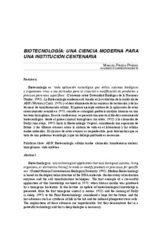Biotecnología: una ciencia moderna para una institución centenaria
Autor
Pineda Priego, Manuel
Editor
Real Academia de Córdoba de Ciencias, Bellas Letras y Nobles ArtesFecha
2011Materia
ADNBiotecnología
Células madre
Clonación
Transferencia nuclear
Transgénicos
Vida sintética
DNA
Biotechnology
Cloning
Nuclear transfer
Stem cells
Transgenics
METS:
Mostrar el registro METSPREMIS:
Mostrar el registro PREMISMetadatos
Mostrar el registro completo del ítemResumen
Biotecnología es “toda aplicación tecnológica que utilice sistemas biológicos
y organismos vivos o sus derivados para la creación o modificación de productos o
procesos para usos específicos” (Convenio sobre Diversidad Biológica de la Naciones
Unidas, 1992). La Biotecnología moderna está basada en la estructura de la molécula de
ADN (Watson y Crick, 1953) y el descubrimiento de las enzimas de restricción y de las
técnicas de transformación celular. El primer ejemplo exitoso de la aplicación de estos
conocimientos ocurrió en 1978, cuando se consiguió producir insulina humana en una
bacteria transgénica. En esta conferencia, se presenta una puesta al día del conocimiento
biotecnológico, desde el primer animal transgénico (un ratón, 1982) y la clonación de
Dolly (una oveja, 1997) hasta la Biotecnología Vegetal, considerada una esperanza de
futuro, y los últimos avances como la síntesis de vida en el laboratorio y las células
madre inducidas. El alcance de estos avances es impredecible, pero demuestran que se
trata de una poderosa tecnología y que un diálogo profundo es necesario. Biotechnology is “any technological application that uses biological systems, living
organisms, or derivatives thereof, to make or modify products or processes for specific
use” (United Nations Convention on Biological Diversity, 1992). Modern Biotechnology
is based on the duplex helix structure of the DNA molecule, the discovery of restriction
enzymes and the cell transformation techniques. The first example of a successful
application of this knowledge occurred in 1978, when human insulin was produced
by a transgenic bacterium. In this lecture, an update of biotechnological knowledge is
presented, from the first transgenic animal (a mouse, 1982) and the cloning of Dolly
(a sheep, 1997) to the Plant Biotechnology, considered a hope for the future, and the
last advances such as synthesis of life in the lab and the induced pluripotent stem cells.
The implications of these advances are unpredictable, but they demonstrate that is a
powerful technology and that a deep dialogue is necessary

